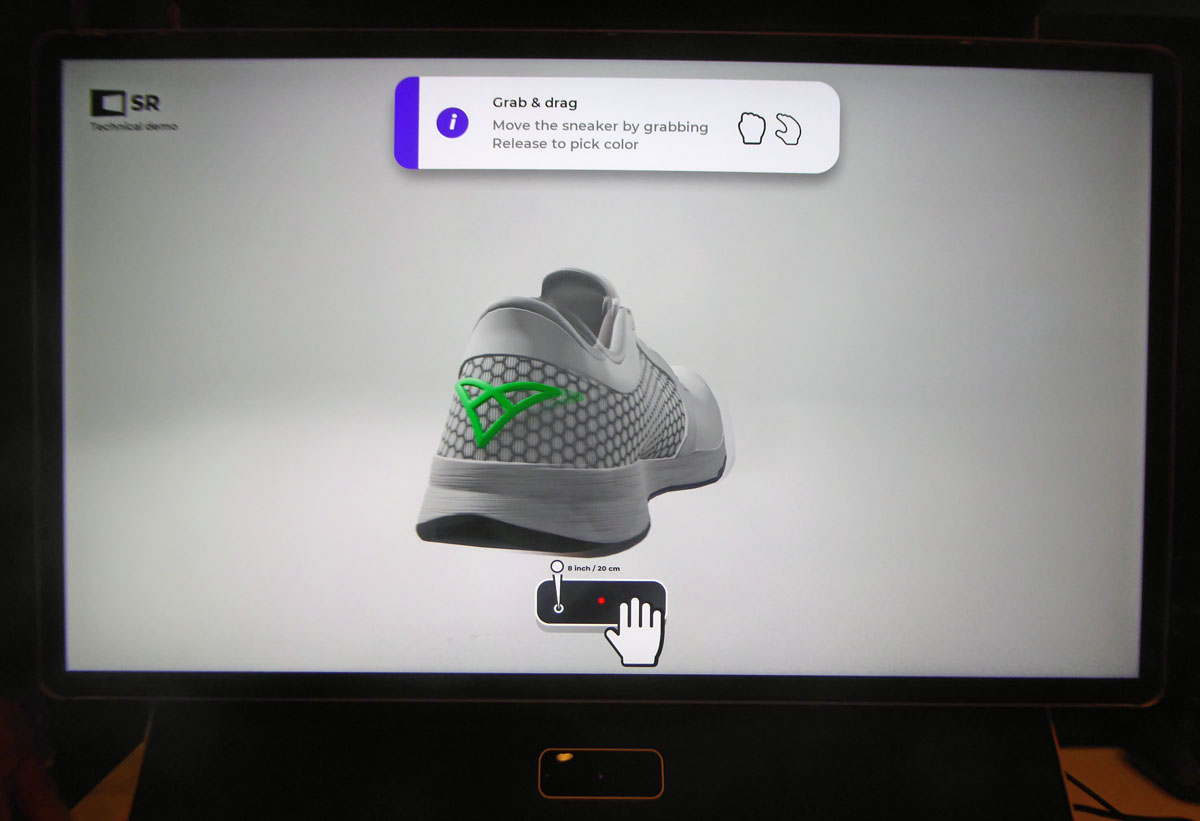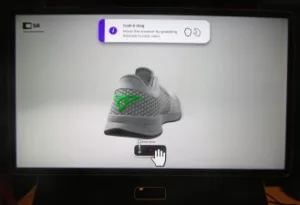My schedule at CES can keep me so busy that I rarely venture away from the Las Vegas Convention Center. The show also occupies the Sands Expo Center, where additional exhibits fill the show floor and suites and ballrooms at the nearby Venetian are loaded up with everything from high-end audio manufacturers to all kinds of exotic product demos.

But I set aside time this year for a visit to the Venetian to check out two companies – Dimenco, based in The Netherlands, and Looking Glass, out of Brooklyn, NY. Both companies touted next-generation autostereo displays built on 32-inch and 31.5-inch 8K LCD monitors, and both used different approaches to create 3D images.
Dimenco calls their product Simulated Reality (SR), and its unique selling proposition is an eye-tracking system that dynamically remaps two views – one left eye, and one right eye – depending on where your head is positioned. I took it for a test drive, viewing a stereoscopic image of an athletic shoe model. The 3D rendering was quite effective, even as I moved my head side-to-side.
What makes the Dimenco autostereo display (based on a Sharp 8K LCD panel) so effective is the addition of a gesture recognition system. Once your hand is detected, you can “grab” the shoe and rotate it clockwise and counter-clockwise, and the speed of rotation is determined by how fast your hand moves – a quick side-to-side swipe will completely spin the shoe 360 degrees, or you can slowly turn it in precise steps. You can also push the object back and pull it forward.
 Dimenco’s eye- and gesture-tracking 8K autostereo monitor lets you rotate objects and move them forward and backward. Image:P Putman
Dimenco’s eye- and gesture-tracking 8K autostereo monitor lets you rotate objects and move them forward and backward. Image:P Putman
Dimenco partner Ultraleap developed this gesture recognition and control system (Leapmotion), and it works so well that I felt I was spinning an actual shoe on a turntable. Ultraleap’s specialty is haptics and it is also offering mid-air haptic feedback as an add-on to SR. The dynamically-shifting dual-view system presents images with very high resolution, but there’s a catch – it can only be used by one person at a time. A spatial sound system is parked atop the monitor for full immersion.
Looking in the Glass
A few ballrooms further down the hall, and tucked into the back of the Seagate suite, I found Looking Glass set up with their 8K autostereo display, a motorized camera for capturing multiple views, and a large green screen system for creating virtual backgrounds. Looking Glass’ 8K Immersive autostereo display was covered in an earlier Display Daily (The Looking Glass Lightfield / Volumetric Monitor) by my colleague Chris Chinnock, and it differs from Dimenco’s SR product by having 45 separate left eye/right eye views.
The advantage of such a system is that more than one person can be viewing simultaneously, although that could get crowded around the 31.5” LCD monitor (an LG Display product). The downside is that each view has much lower resolution, but with 33 million pixels to begin with, that’s not nearly as much of a drawback as it was ten years ago with Full HD autostereo displays.
Looking Glass has done such a good job with its light-field capture system and subsequent image processing that they can pull off some cool dimensional effects. One in particular featured a magnifying glass hovering over a map – as your perspective changed, the view through the magnifier also changed, but so did the optical distortion at the edges of the magnifying lens, just as you’d see with a real magnifier. Results were just as impressive with motion video.
 The Looking Glass 8K Immersive Viewer provides 45 different stereoscopic views, but no eye or head tracking. Image:P Putman
The Looking Glass 8K Immersive Viewer provides 45 different stereoscopic views, but no eye or head tracking. Image:P Putman
With some content (mostly with light-colored backgrounds), I noticed that when I crossed a parallax barrier as I shifted my viewing position I observed brief crosstalk. In contrast, I never spotted a parallax barrier or experienced crosstalk with the Dimenco system – that was only seen shooting video with my “monocular” video camera.
The Dimenco representative said that SR development kits (monitor, software, haptics) would be available this year for $22,000. Looking Glass will also start shipping their monitor this year. They didn’t discuss a retail price, but they also sell seven home-grown software tools for creating holographic (autostereo) images along with five third-party applications; host a gallery of images created with Looking Glass, and provide links to developer forums on their Web site.
I’ve long advocated for glasses-free virtual reality and stereoscopic viewing systems that work for everyone, whether they need corrective eyewear or not. And both of these products show that, if you have enough pixels to start with, you can indeed build an effective, glasses-free autostereo display that creates very realistic, “reach out and touch them” 3D images. I can’t wait to see larger models for even more immersive viewing. (PP)

